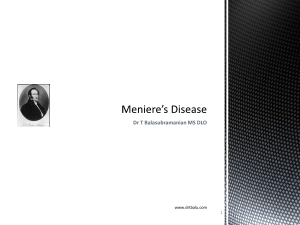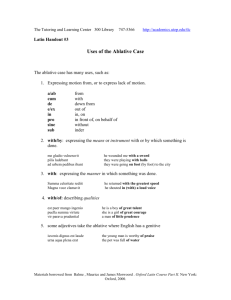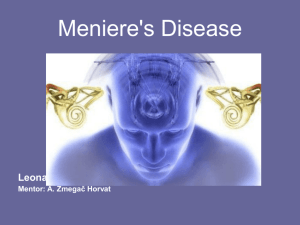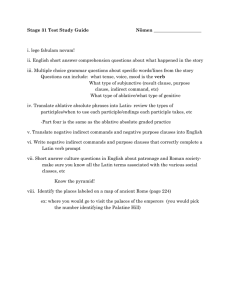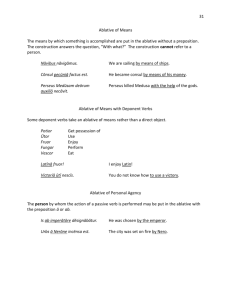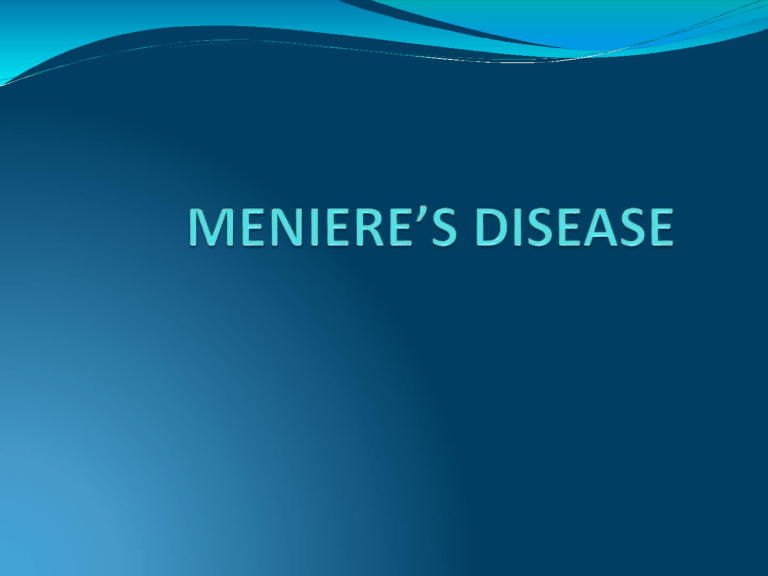
Introduction Meniere's disease (idiopathic endolymphatichydrops) is a disorder of the inner ear associated with a symptoms consisting of spontaneous, episodicattacks of vertigo; sensorineural hearing loss whichusually fluctuates; tinnitus; and often a sensation of aural fullness. dramatic variability is the hallmark of this disease. ENDOLYMPHATICSYSTEM Functionsof ENDOLYMPHATIC sac 1. Resorption of the water content of endolymph 2. Ability to participate in some ionicexchanges with endolymph 3. Removal of metabolic and cellular debris, includingotoconia 4. Immunodefense function ( perisaccular) 5. Inactivation and removal of viruses 6. Secretion of Glycoproteins to attract extra fluid (Glycoproteins act as a driving force for longitudinalflow) 1. Secretion of Saccinto increase Endolymph production Introduction : History First described by Prosper Meniere in 1861. In 1902, Parry performed a CN VIII division for vertigo in a patient with suspected Meniere’s disease. Portman did endolymphatic sac decompression via a transmastoid approach in 1926. In 1931,McKenzie performed a selective vestibular neurectomy. Pathology Distortion of the membranous labyrinth. This condition reflects the changes in the anatomy of the membranous labyrinth as a consequence of the over-accumulation of endolymph. Mainly affects scala media and saccule Bulging of reissner’s membrane Saccule may come to lie against the stapes footplate. Etiology A. Defective absorption by endolymphaticsac• Poor vascularity of sac • Less absorptive tubularepithelium • increased perisaccular fibrosis B. Rupture of reissner’s membreane leading to mixing of perilymph & endolymph- Schuknecht • allow leakage of the potassium-rich endolymph into the perilymph, bathing the eighth cranial nerve and lateral sides of the haircells Etiology Spasm of int. auditory artery – Sym.Overactivity Allergy – inner ear is shock organ Sodium & waterretention Hypothyroidism Autoimmune Viral Clinical features Affects in 4th -5th decade of life Male:Female 1:1 Prevalence more in whites. VERTIGO : episodic attacks , asso. with nystagmus, nausea & vomiting , vagal disturbance Tullio phenomenon may be seen • Otolithic crisis of Tumarkin o are thought to occur as a result of acute otolithic dysfunction. o The patient simply drops to the ground without warning and can sustain a fracture or other serious Injury • Lermoyezsyndrome • described an unusual clinical presentation in which tinnitus and hearing loss precede the onset of vertigo Clinical features HEARING LOSS 1. 2. 3. 4. 5. 6. Fluctuating SNHL Progressive Unilateral Distortion of sound Intolerance to loud sound Clinical features TINNITUS Low pitched roaring 2. Subjective 3. Unilateral AURAL FULLNESS 1. Fluctuates , in prodromal phase 1. Diagnosis Investigations Tuning forks tests : SNHL PTA Speech audiometry Recruitment test +ve SISI >70% Tone decay <20 dB Investigations Caloric testing – canal paresis ENG Head Thurst test ECoG – SP is larger & more negative SP/AP ratio increases > 30% Glycerol test VEMP – elevated threshold VEMPs Staging STAGE PURE TONE AVERAGE IN dB IN PREVIOUS 6 MONTHS 1 = < 25 2 26-40 3 4 41-70 >70 Variants Cochlear hydrops – novertigo Vestibular hydrops – no heaing loss Drop attacks Lermoyez syndrome- hearing loss followed byvertigo Treatment Medical management – ACUTE stage : labyrinth sedatives +anti-emetics Carbogen, Histamine drip Frustenberg Regimen 1. 2. 3. Low saltdiet Diuretics + Pot. chlor High protein Beta histine – to relieve vascular ischemia Stop caffeine, nicotine, alcohol & tobacco Non ablative procedures Portman -1926 Endolymphatic sacsurgery Subarachnoid shunt 2. Mastoid shunt 1. Non ablative procedures Intratympanic steroids May benefit in autoimmune causes of meniere’s syndrome. Sacculotomy Cochleosacculotomy Ablative procedures Intratympanic gentamicin – Schuknecht(1957) Ablative procedures Selective Vestibular nervesectioning Ablative procedures Ultrasonic destruction of vest.Labyrinth Cryodestruction Labyrinthectomy - when cochlear function has been totally deteoriated ,higherrate of vertigo control seen than that typical for vestibularneurectomy Recent advances decrease hydrops by pulsing pressure in themiddle ear Meniett device - handheld air pressure generator that the patientself-administers The pressure is delivered in complex pulses of up to 20 cm of water, over a 5 minute period. The device requires a ventilation tube to be placed in the tympanic membrane before initiation of therapy Pressure at the RW passes to perilypmh and decreases pressure in endolymph by redistributing it.


